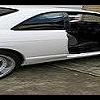Pics Hks 2835 Install
Announcements
-
Similar Content
-
Latest Posts
-
Never an issue with boost control. No weird boost issues pre throttle at partial throttle like you're suggesting. It worked. As for all the turbo damage claims, they all were started by aftermarket BOV companies. At least turbo timer companies had SOME truth about them, except people failed to realise that except for in extreme circumstances, that small amount of driving you do to park/ through pit lane etc, is enough to not have a need for a turbo timer.
-
By joshuaho96 · Posted
I tell people all the time this stuff runs on a 2 MHz 8-bit MCU. The math is a bit arcane, they do a lot to get around their limited resolution and so on but it works great as-shipped. So if an 80 to 160 MHz modern 32-bit MCU can't make it work you've really screwed something up badly. Your average graphing calculator is faster these days, god forbid we start talking about what's hiding in vapes or some stupid internet-connected "smart appliance". I suspect the lore about off-throttle surge damaging turbos must be very, very old if it was ever true. I still don't think off throttle surge is good for turbos because you're rapidly having air going in and out of the turbo on top of rapid loss in shaft speed which presumably does impart some kind of unusual load on the rotating assembly. As for the recirculating valve, I believe Nissan actually in a press slide deck of some kind explained for the RZ34 they found it improved response. Prior to that they kept the throttle cracked open instead which causes rev hang and because the throttle/engine is a substantial restriction a ton of the energy in the air stream is lost just to pumping past it. Recirculating helps reduce energy loss by bringing the intake side of the compressor up in pressure so it's not working as hard to pull air in. In DCT cars where they can slam gears I believe Porsche hangs the throttle wide open with no fuel injection to keep turbo RPMs as high as possible during the shift. As for running post-throttle boost source, I would be concerned that at partial throttle on boost you would have driveability issues. It would be constantly trying to run crazy amounts of boost before the throttle to compensate for the throttling effect. Maybe with a much more sophisticated boost control setup you could activate a solenoid that goes from a conventional 3-port setup to something that allows the wastegates to see full vacuum in that specific case? -
Did you clean everything out? Take all intercooler piping off, empty the intercooler of oil, clean the exhaust out, etc? Intercoolers make great catch cans... Which makes them less useful for intercooling... But very worth cleaning out, along with all adjoining piping.
-
By pacman_1219 · Posted
Update Got turbo back from hypergear, installed everything etc. Bled coolant, wasn't smoking so I thought beauty she's sorted now. Went on a drive, car up to temp, let it idle for about 15 seconds, gave it some gas...nice puff of smoke again. Fml No doubt my turbo was pretty worn anyway but nonetheless frustrating that the problem persists.







Recommended Posts
Create an account or sign in to comment
You need to be a member in order to leave a comment
Create an account
Sign up for a new account in our community. It's easy!
Register a new accountSign in
Already have an account? Sign in here.
Sign In Now